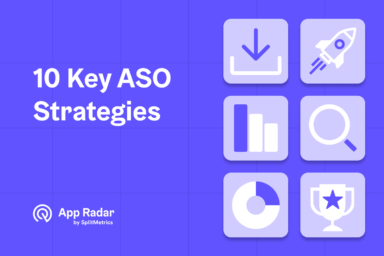ASO KPIs: How to Measure Your App’s Success on App Stores
App success hinges on understanding your data. In this guide, we'll show you the key performance indicators (KPIs) for App Store Optimization (ASO) that you need to track to stand out on the App Store and Google Play. These are the same essential metrics top app marketers use to drive growth. In this extensive guide, we will show you the core ASO KPIs that you need to closely track and improve.
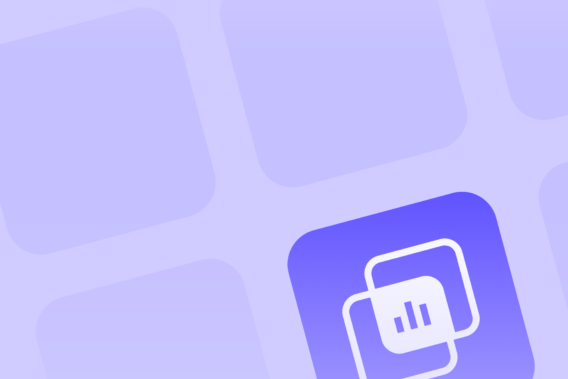
What are ASO KPIs and why are they important?
ASO (or app store optimization) KPIs are key performance indicators of mobile app’s performance in app stores such as Google Play and the App Store. The KPIs and metrics allow us to measure the impact of our work and show us if our efforts provide results or not.
ASO metrics and KPIs are necessary because they provide insights into all your activities – from small wins to the overall impact on your user acquisition.
Generally speaking, mobile apps pursue different goals depending on the stage they are currently at. All apps and mobile games want to push organic growth, increase conversion rates, get more installs, reduce user acquisition costs, increase revenues, improve user retention and engagement, etc. ASO metrics should always be a part of the success measures during each stage of app lifecycle.
App store optimization or ASO is done to optimize an app’s organic performance and contribute to the overall growth of your organization. Not only do metrics demonstrate the value of marketing efforts, but they also help you answer crucial questions, such as where to invest your budget and time.
If you know what works and what doesn’t with your ASO, you can make strategic decisions and drive business outcomes with tailored ASO strategies.
Why understanding app traffic sources is vital?
Before jumping into app metrics and KPIs, you should understand where your users come from. As an app marketer, you need to invest your resources into areas with the biggest opportunities for user acquisition.
Although there are many app stores, by far the biggest ones are Google Play Store and the App Store. Each of them have different terminology and definitions of traffic sources.
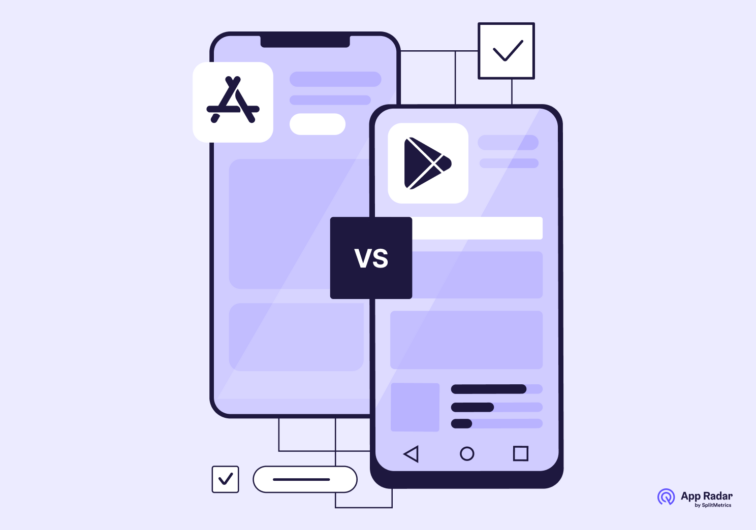
Google Play traffic sources
There are three main traffic sources for Android apps in Google Play:
- Search consists of users who performed a search on Google Play for your app’s name or closely associated brand and landed on your store listing. Visits from ads in search results are not included.
- Explore traffic consists of users who come from Google Play (e.g. featured sections throughout the store), categorical search results (e.g. racing games) and who click on search autocomplete suggestions (e.g racing games for free). Visits from ads across Google Play are not included in Explore traffic.
- Third-party referrals are those users who came outside of Google Play to your store listing. However, ad users are included here, such as those who click on Google app campaigns across different Google properties.
Important to mention for all three traffic sources is that these definitions are only true for visitors that didn’t have installed the app on any devices before.
Make sure to check official Google Play documentation from time to time. Google Play often changes the definitions of traffic sources and you need to understand which store listing visitors and installs attribute to which traffic sources.
App Store traffic sources
Apple’s App Store has overall six categories of traffic sources:
- App Store Search – users who viewed or downloaded the app for the first time after performing App Store search
- App Store Browse – users who viewed or tapped to download the app for the first time during App Store browsing (e.g. in the featured, top charts or categories sections).
- App Referrer – users who tapped a link in different app that brought them to your app’s product page
- Web Referrer – users who came to your product page from a website
- App Clip – users who tapped a link in your App Clip that brought them to your App Store product page and downloaded the app after that.
- Unknown – users that came through traffic sources that Apple can’t attribute to other groups. Usually the figures here make a very small portion of your total traffic.
What is the difference between Google Play and App Store funnels?
There are some fundamental differences between Google Play and App Store funnels.
Google Play differentiates from Apple’s App Store in a way that you can’t get the data for impressions, that is, you can’t compare all conversion rates directly between the stores.
Differently said, Apple tracks app views and conversion rates when someone sees your app anywhere in the App Store, while Google shows app views and conversion rates only after the users land on the store listing page.
A typical organic funnel in Google Play looks like this:
- A user sees an app in search results or somewhere in the store (we don’t get exact numbers of these views).
- That user taps one of the apps and lands on the store listing page (Google Play shows those visits and traffic sources).
- If the user is interested in the app, he or she will download the app (these figures are provided by Google Play as well).
Google Play Store listing visitors = the number of users that visited your store listing and didn’t have the app installed on their other devices. Store listing acquisitions in Google Play show the number of users who visited your store listing and installed your app.
A typical organic funnel on the App Store looks like this:
- A user sees an app in search results or somewhere in the store (Apple provides this data and it is called impressions).
- That user taps one of the apps and lands on the product page (Apple provides data on those visits and traffic sources).
- If the user is interested in the app, he or she will download the app (these figures are provided by the App Store as well).
App Store impressions = the number of times your app was viewed in the Search, Today, Games and Apps tabs. It also includes your product page views. App installs on the App Store are called app units and show the number of first-time app downloads made on the App Store. App updates, downloads from the same Apple ID and redownloads are not counted. However, family sharing downloads are included for free apps.
Apple’s conversion rates show the download percentage from the first app view and all the way to the download.
Google Play’s conversion rates focus more on how efficient the app’s assets are in convincing users to download the app. That is why conversion rates are higher in Google Play than on the App Store – because the store listing visitors already show interest in the app by clicking on the icon or app name and are more likely to to download the app.
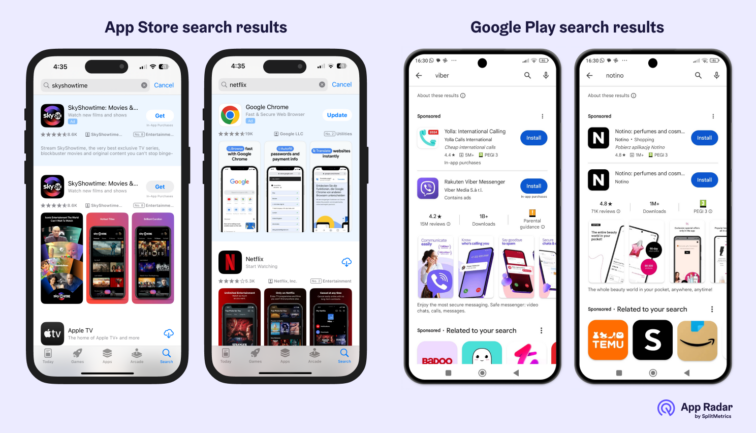
In short, Google Play and Apple App Store funnels can’t be compared directly. In addition to different metrics, users can install an app directly from the search results in the App Store. On the other hand, Google Play users can’t do that, except when performing brand searches – in that case, the search result will add the “install” button next to the search result.
How to understand organic installs properly?
Once you have a good understanding of the app’s traffic sources, you need to make sure that you understand the definitions app stores use for their own metrics.
In case you are just starting with your app journey, a simple formula for total installs an app can get is:
Total Installs = Organic Installs + Non-Organic Installs
Organic installs represent users who come to the store listing page without having seen an ad. App store users can find an app via different organic channels. Searching and browsing the app stores are the most common methods of app discovery.
Non-organic installs represent users who discover an app through ads. Typical ads are Apple Ads, Google app campaigns, or on any social media network ads. Whenever people click on the ads, app developers pay a fee to bring users to their store listings.
Apple doesn’t separate organic downloads from non-organic downloads – paid search ads downloads are mixed with organic search downloads in App Store Connect. On the other hand, Google Ads downloads are shown as third-party referrers in the Google Play Console, but there are also other ads and user sources that make the analysis complex, such as social media ads, web referrers, etc.
The second crucial thing to understand is the difference between app downloads and installs:
App download = user downloads an app on a device.
App installs = A user launches an app for the first time after downloading it and it is recognized as the installation
Make sure to understand the definitions properly because your KPIs will be wrong if you misinterpret them.
How do ASO terms differ between Google Play and App Store?
Apple, Google, and MMPs (mobile measurement partners), such as AppsFlyer or Adjust) use different names for downloads and installs and understand them differently. The Apple’s analytics make this even more confusing by calling downloads “Installs,” which are the sum of “New downloads” and “Redownloads.”
It is quite difficult for app marketers to understand what is actually measured by each metric. For the start, you need to remember that an app download is counted when a user downloads an app on a device, even if the user doesn’t open it on the phone or tablet. App download is a signal that a user is interested in using the app.
An app install is counted only when the user launches the app, because it indicates that the user is exploring the app’s features.
Most of the time, the number of downloads doesn’t match the number of installs. This is because some users do not open the app after downloading it.
For example, a user might accidentally click on the “GET” button (on the App Store) or “INSTALL” button (in Google Play) before realizing later they have downloaded the wrong app, which they simply uninstall and never open.
And according to AppsFlyer, this happens to about 20% of users, which causes data discrepancies between the developer consoles and MMPs.
The App Store and Google Play consoles name downloads differently from one another. The definitions are also slightly different but they mean more or less the same thing: download. Specifically, the App Store refers to first-time downloads while Google Play counts downloads when the user hasn’t yet installed the app on any devices.
An important thing to mention is that ASO improvements often increase performance in non-organic traffic and related KPIs. All users will eventually arrive on the App Store or Google Play to download an app, so optimizing the store listing will have a certain impact on conversion, even if the users come from paid campaigns such as Facebook or Google Ads.
What are the main ASO metrics and KPIs?
There is no shortage of app metrics that you can track. As an app marketer, one of your tasks should be to define the metrics that matter for your app and that are tightly connected to your business.
While every app has its specific aspects, there is a good number of metrics and KPIs that every app owner should track. These metrics include:
- Store visibility metrics
- Conversion rate metrics
- General app performance metrics
Let’s have a look at each group and provide more detail about their metrics.
Store visibility metrics and KPIs
Store visibility metrics relate to everything that directly influences an app’s visibility in the app stores. Or differently said, increasing visibility in app stores means to increase an app’s reach within the stores.
A positive visibility impact could be, for instance, that your app ranks for more keywords than before and that it captures top 5 ranking positions for popular and relevant app keywords.
The reason why we work on app store optimization is to maximize the chances that a user will see our app in different places. We want our app to be visible in the search results, on the store homepage or listed under different recommended sections.
If we perform a specific ASO activity to increase apps’ visibility, we should expect that impressions or store listing visitors increase if the optimization is successful. We can and should also monitor the acquisition source and traffic source breakdowns to understand which channels contribute the most to the visibility increase.
For instance, App Store “Browse Impressions” will jump if the app gets featured. App Store “Search Impressions” will increase if the app keyword optimization was properly done.
A common and important store visibility metrics include:
- App impressions in search results and in the store (App Store only)
- Store listing visitors (Google Play) and Product page impressions (the App Store)
- Keyword rankings for target keywords
- Top chart rankings
- Category rankings for your category
- Similar apps associated with your app
- Featurings – countries and locations in app stores
- Ratings and reviews
- Android vitals
We can quickly define what these metrics mean.
App impressions in search results and in the store (App Store only)
App Store Impressions on the App Store refer to the “number of times an app is viewed on the Today, Games, Apps, and Search tabs”, as well as on its own product page. Apple registers an impression only if an app is viewed for more than one second to make this metric reliable.
This metric can’t be found in Google Play and only the App Store tracks impressions.
Store listing visitors (Google Play) and Product page impressions (the App Store)
Store listing visitors are users who visit an app’s store listing on the Google Play store without having the app installed on other devices.
Apple defines App Store Product Page views as the number of times an iOS user views your app’s product page in the App Store.
Both of these definitions are very similar for each app store.
Keyword rankings for target keywords
App keyword rankings are the positions an app holds in search results for a specific keyword or phrase in app stores. The rankings are important because they positively correlate with app visibility and the number of organic downloads an app can get.
Higher rankings for relevant keywords lead to increased traffic to the app’s product page and more potential installs.
Top chart rankings
App top charts in app stores are lists of the most popular apps in a particular category or overall, ranked by download numbers, user ratings, and other factors.
They are important because they show how apps perform in comparison to competitor apps.
The top charts also serve as a discovery tool for users, helping them find new and popular apps in their respective categories. A high ranking on the top charts often results with more downloads attributed to the Explore or Browse sections.
Category rankings for your category
The higher an app ranks in its respective category, the more visible it becomes to potential users and the more chances it has to be featured and bring additional app downloads.
Similar apps associated with your app
Similar apps are those that target the same audience as your app. They matter for app visibility because they help users discover and compare similar apps.
When a user is browsing an app store, they may come across an app they like, and then look at the similar apps section to find other options that suit their needs.
Being listed as a similar app for a popular app in the same category can add an extra layer of visibility and more potential downloads.
Featurings - countries and locations in app stores
App featurings refer to apps promoted by the app stores, such as being featured on the homepage or in a curated list.
The results of app featuring reflect in spikes in Browse impressions (App Store) or Explore store listing visitors (Google Play). If the app featuring was effective, the downloads will go up as well together with a drop in Browse and Explore conversion rate and total conversion rate. This is because many people will see the featuring, but not many of them have the intent to download your app.
As an app marketer, you want to track where and when your app gets featured to better understand its impact and contribution to your overall traffic.
Ratings and reviews
App ratings and reviews are feedback left by users on an app’s listing page in app stores. They serve as social proof and influence potential users’ decisions to download or not.
Higher ratings and positive reviews indicate that an app has high quality, it is reliable and valuable, which increases the likelihood of downloads.
Additionally, app stores use ratings and reviews as a ranking factor – apps with higher ratings and more positive reviews are more likely to appear in top results.
Android vitals
Android vitals are Google Play metrics that help developers to identify and fix issues that affect the stability and performance of their apps. Android vitals monitors various aspects of an app’s performance, including battery consumption, app crashes, and ANR (App Not Responding) rates.
Android vitals impact app visibility because they affect the user experience. While you can’t see Android vitals somewhere in Google Play, you should track them in Google Play Console because they can harm app’s visibility and reputation.
Conversion rate metrics and KPIs
App conversion rate refers to the percentage of users who perform some kind of action in app stores that is tied to your app store goals. Those actions can be views, clicks, downloads or whatever is important for your app.
App conversion rates indicate how effective app store listing is at attracting potential users. E.g., a high download conversion rate means that a larger percentage of users who view the app listing end up downloading the app.
Conversely, a low conversion rate may indicate that the app listing needs improvement in terms of its icon, screenshots, description, or other elements. For example, your app screenshots should provide enough information about your app and if possible, directly address user intent.
As app marketers, we want to monitor app conversion metrics and KPIs to improve the store listing and maximize the probability that a user will download the app.
Many app marketers try to compare these main conversion rates for many reasons such as evaluation of marketing activities, reporting purposes, etc. However, the majority of users on the App Store download the app directly from the search results – every app that appears in the search results can be installed without visiting the store listing page first.
Conversion rate varies by traffic source depending on user intent. The conversion rate from Search is generally higher than Explore or Browse conversion rates – users who come from Search have a higher intent to download an app from the presented results (this is even more emphasized for brand names).
The conversion rate of web referrer, app referrer, and third-party referrals is influenced by performance, paid marketing strategies and organic traffic from the website. So if you want to monitor conversion rates systematically, always look at the traffic sources and their conversion rates to get a holistic view of overall performance.
While not all conversion rate metrics might be important for your business (especially if you focus on organic or paid acquisition only), we still recommend paying attention to the following metrics.
- Google Play Store listing conversion rate (Google Play)
- Impression to App Store units (the App Store)
- App installs (Google Play and the App Store)
- Conversion rate vs peers (Google Play)
- Impressions to product page views tap-through rate (the App Store)
- Impressions to downloads conversion rate (the App Store)
- Product page views to downloads conversion rate (the App Store)
- App page conversion rate: First-time downloads to unique page views (the App Store)
- Install rate: First-time downloads to unique impressions (the App Store)
- Search conversion rate: first-time downloads to impressions (unique), filtered by Search source type (the App Store)
Let’s have a quick look at those metrics as well.
Google Play Store listing conversion rate (Google Play only)
The store listing conversion rate in Google Play tells you how many people visited your store listing page and downloaded your app afterwards.
Google Play Store listing conversion rate = the percentage of store listing visitors that installed your app. Make sure to measure the conversion rate per source level: Search, Explore and Third-party referrers.
The improvements you do on your store listing should increase the chance that each visitor (measured by store listing visitors in Google Play console) decides to install your app.
Inside the Google Play Console you can access conversion rate of your app vs. peers, which helps us to determine how your app’s performance compares to the competition.
This data is useful because you want to compare your app with the competition. Also, if your competitors receive many keyword rankings and have high conversion rates, you will be able to estimate better if increasing conversion rates pays off or not.
Shifts in store listing visitors can also cause changes to your conversion rate, even if you don’t work on the conversion optimization. If keyword rankings change because of competition changes, algorithm updates, or seasonality, your conversion might change, even if your store listing didn’t change.
Impression to App Store units (App Store)
The impression to App Store units is the most general type of conversion rate that is easy to understand.
Impression to App Store units = number of app units divided by number the total unique device impressions
The average conversion rate on the App Store is different from Google Play. The main reason lies in the fact that Apple shows app impressions – when users see the app icon somewhere in the store.
Google Play doesn’t show app impressions in search results or if your app icon is viewed somewhere in the store. The only impression that counts is when a user arrives on the store listing page.
As a result, conversion rates on Google Play are much higher because user search intent is stronger – when someone navigates to the store listing page by clicking on your app icon, the intent is already strong enough and the conversion probability is higher.
App installs
App installs are the most obvious and typical metric for measuring the impact of visibility improvements. But app installs are also an important KPI to measure the success of your conversion rate optimization efforts.
The ultimate goal of ASO should always be higher install volume. If you improve conversion rates, the number of installs you receive will go up. This will be closely connected to better keyword rankings – your app will receive better rankings in search results, convert more visitors into users and again be rewarded with more positive organic placements.
Impressions to product page views click-through rate (the App Store)
This top-of-funnel metric is useful to understand the ability of your app preview screenshots or video in encouraging store visitors to take a deeper look. This helps to determine how well app preview attracts users deeper into your product page.
Nevertheless, a product page view does not always generate an install, but it is still valuable to track this KPI to understand how efficient your app funnel is.
Impressions to downloads conversion rate (the App Store)
This fundamental ratio is a KPI for measuring conversion rate performance from the (unique) viewer to install conversion rate on the App Store. Making improvements to your metadata and creatives is ultimately done with the goal of increasing the chance that each person in Search and Browse decides to install your app.
Similar to Google Play, make sure to measure the conversion rate per source level. Search and Browse are the main factors to track organic progress, but you can include referrer channels as well to have a full picture.
Product page views to downloads conversion rate (the App Store)
To measure changes that only affect your product page on the App Store, you must measure the product page view to downloads conversion rate. Elements that affect your product page view conversion rate include promotional text, description, screenshots and video.
Also, your product page contains other elements such as What’s New, the app info, header image on your app’s product page, promoted in-app purchases, etc.
Don’t forget – paid campaigns send users to your product page as well and can skew this conversion rate.
Apps can have a higher number of downloads than product page views in the App Store, since users can directly install your app from search results. That is why we recommended focusing more on the impressions to download conversion rate than this one.
App page conversion rate: First-time downloads to unique page views (the App Store)
This ratio shows the number of new app downloads from your product page.
Selecting “first-time downloads” rather than “installs” in App Store Connect excludes re-installs from users who had already downloaded your app. Our suggestion is to use this ratio to measure the conversion of referral and paid advertising campaigns that lead directly to your app’s product page.
App Store users are able to download apps straight from search results without having to ever open the app’s product page, which means this ratio can be greater than 100% if your installs originate mostly directly from the search results.
Install rate: First-time downloads to unique impressions (the App Store)
This is the most commonly referred ratio when talking about “conversion rate” in the App Store. It measures any downloads coming from new users.
For instance, if a user sees the app in search results and then lands on the product page, only one impression will be counted for that user if you select “impressions (unique devices)”.
Search conversion rate: first-time downloads to impressions (unique), filtered by Search source type (the App Store)
This ratio is probably the most important conversion rate you want to work on – it considers only organic traffic sources and doesn’t look at changes in paid UA strategy or impressions that come from app featurings.
Other important metrics to complement ASO metrics
While it is great that your app has more visibility across the app stores, gets more installs and has high conversion rates, your business metrics need to grow as well.
Your app business will most likely focus on a dozen different metrics and KPIs. The ones that we see as the most important ones are:
- Mobile growth metrics such organic uplift that occurs as a result of paid campaigns
- Average revenue per user (ARPU) – total revenue divided by the number of users.
- Lifetime value (LTV) – a prediction of the net future profit for a particular user.
- Revenue – total amount of income generated with Google AdMob, Facebook campaigns, in-app purchases, subscriptions, etc.
- User retention – users that use your app or game day 1, day 7 and day 30 after the download
We won’t go into detail about those, but we highly recommend that you pick general app metrics next to ASO ones.
App quality and performance metrics
Beyond traditional ASO factors, the app stores now use your app’s technical quality as a direct ranking signal. Metrics like Android Vitals (crash rate, ANR rate, and excessive battery usage) and similar performance indicators for iOS are crucial. A high-quality, stable app with strong user engagement is rewarded with higher visibility. By monitoring metrics such as user retention and DAU/MAU ratios, you signal to the app stores that your app provides a valuable user experience. Therefore, a modern ASO strategy requires a holistic approach that connects your app’s technical performance with its marketing efforts.
How to understand the complexity of ASO metrics?
ASO metrics can be complex – you should always look at ASO metrics with caution. It is easy to make some conclusions when correlations appear, but we suggest to pay additional attention to the following situations:
- Conversion rates highly depend on a change in traffic structure, e.g. branded vs generic traffic. Branded traffic converts better than search traffic coming from generic keywords. So if you rank higher for more generic keywords (while keeping the branded traffic the same), your search conversion rates will decline.
- Your ultimate goal should always be more installs. For that reason, always improve your app and A/B testing by choosing the elements that will most likely have the strongest impact on the app installs.
- User acquisition should be seen holistically – e.g. Browse and Explore downloads can grow when you invest in paid campaigns, since people are more exposed to your brand. This growth in downloads also results with better category positioning and higher rankings in top charts.
Keep the big picture in mind and check how your entire KPIs and acquisition channels move together with your marketing campaigns.
Final thoughts about ASO KPIs and metrics
There is no single indicator that can measure the overall success. Apps have different goals and your KPIs and metrics should be there to help you track your progress towards these goals. And app store optimization is one of the goals that needs to have its success measures.
Our biggest recommendation is to keep a holistic view on all the metrics we mention in the article. This means combining them together and watching their progress to get a complete picture of your app’s performance.

Latest Posts
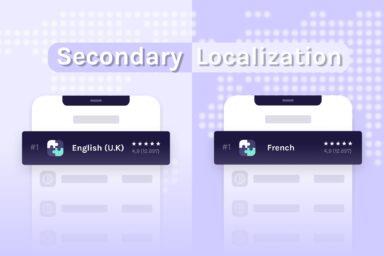
iOS App Product Page Localization: How to Use it the Right Way to Improve ASO
Top 10 Most Downloaded Games in Google Play Store (July 2025 Update)
Google Play Store Listing Experiments: How to Run Native A/B testing for Android Apps for Free!
12 Best Mobile Measurement Partners (MMPs) to Consider for Your Mobile App Attribution in 2025
Academy Lessons
Continue lessons
